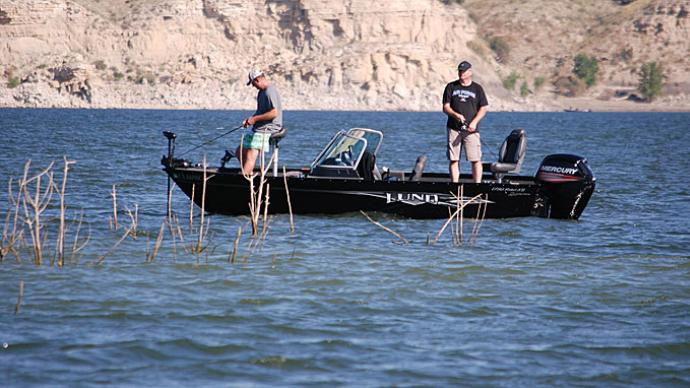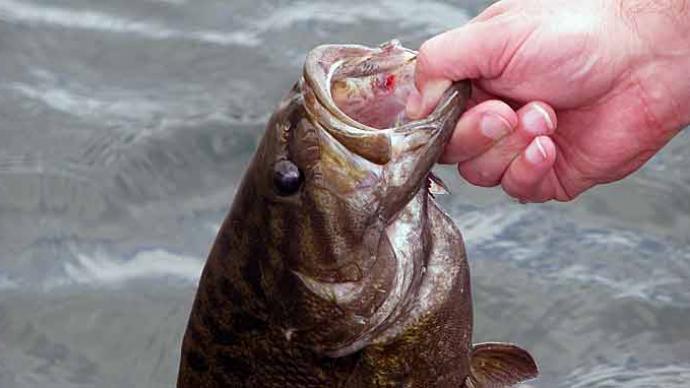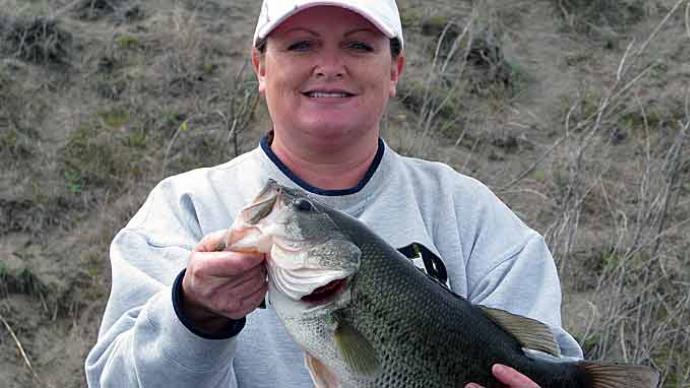
Is there anything worse than trying to fish in the wind? Waves bounce the boat around. The gusts put a giant bow in your line. Simply put, fishing in the wind is a challenge.
However, if you learn how to use the wind to your advantage, you may catch more fish than you ever expected. I asked four respected bass fishermen for tips on fishing in the wind: Gary Dobyns of northern California, Matt Shura of Arizona, Kevin Finley of Arizona, and Eddie Johns of Alabama. Their experiences have one thing in common – the wind can be your friend. Instead of hiding out in a cove or even trailering up and heading home the next time a big wind comes up, try some of their ideas to make fishing in a gale productive, if maybe not entirely enjoyable.
Eddie Johns says that if you can fish in the wind, you can eliminate 90% of the competition. This is good news if you’re a tournament angler, which Eddie is. He says many guys mistake letting the wind dictate what to fish with. They’ll switch to a bigger bait, for instance, even though they have caught fish on a small crankbait. Johns ties up a Carolina rig and his crankbait on it. It will be much easier to cast in the wind. Hold the rod tip up to keep the lure running at the same depth.
Another problem with fishing in the wind is backlashing. Johns has a solution for that. Hold the rod sideways, so the reel is now perpendicular to the water. He says it helps. Let the wind help you – if the wind is blowing from the right, cast the bait toward a spot a couple of feet to the right where you want it, and let the wind blow it to the right spot. Also, don’t sidearm on your cast – keep the rod up instead of off to the side.
He also intensely practiced making himself an ambidextrous fisherman. This takes a lot of time and effort, but Johns does not doubt it was worth the effort. If the wind blows from the left, he’ll cast left-handed and vice-versa, keeping the reel turned on its side. Wind makes no difference to casting if you learn how to be an ambidextrous fisherman.
Since he is a massive fan of Creme worms, Johns has become adept at fishing them in the wind. The main problem with soft plastics in the wind is that the line bow makes it very hard to feel the bottom, much less the bites, plus the wind tends to blow the line, and therefore the bait, wherever it wants. The key to solving these problems is to position the boat so the bow points into the wind, then cast directly into the wind. This way, the wind is working with you on the retrieve. He also holds the reel, so the line runs over his finger to help him feel what’s going on. He may go a little heavier with the weight, but he usually tries to fish as lightly as possible.
Johns positions the boat to head into the wind and trims the motor up. He lets the wind control the back of the boat and only worries about the front. He’ll find a way to fish facing the wind – point-hopping, fishing piers, whatever. After all, he says, a working man only has so much time. Why go home if it is windy on your day off or tournament day? Use the wind to your advantage.
Gary Dobyns has been fishing tournaments for decades and has had to fish in some of the worst conditions. What will you do if a big wind blows up on tournament day? Go home and forfeit the entry fee? Hide in a cove and not catch anything? Gary loves the wind, especially on deep clear lakes like Lake Mead. “Weights are higher on windy days out here,” Dobyns said.
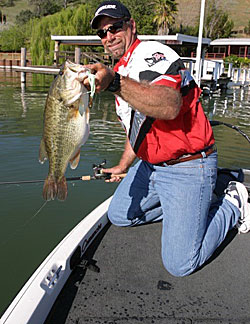
He has always been a run-and-gun kind of guy. He prefers to run from spot to spot, throwing reaction baits or swimming a jig shallow and fast, and that doesn’t change just because the wind has blown up. He says if you’re a reaction bait guy, the last thing you want is a calm day. He doesn’t even change baits or tighten his magnets – he’s just more careful thumbing the reel on every cast.
If the wind is 15 mph or less, he’ll fish into it, but once it hits 20 to 30 mph, he just goes with it, letting the wind push the boat while he controls the distance from shore and keeps throwing those reaction baits. Wind can be a problem in places like the Delta, where current is a factor, especially if it blows hard against the current. That makes for huge waves, but he won’t fish against the current no matter what the wind is.
Wind on a river is a pain in the butt, he says. If the wind is blowing with the current, you have to cast right into it for your bait to come with it. But regardless, he just rides the wind and keeps on casting. Even 6-foot waves aren’t that bad if you fish with the wind, and the only disadvantage, says Dobyns, is that you might have to fish a little faster than you want. The wind is your friend, says Gary, and the clearer the water, the more a friend it is.
Kevin Finley likes the wind for three reasons: light, food, and presentation. The wind blows up the surface of the water and makes the light bounce around like crazy, making it hard for a bass to see your lure clearly – it’s darker in the water on a windy day, plus with all that light bouncing around you can throw all kind of stuff that doesn’t look like natural food at all – like purple with a chartreuse tail. The choppy water also gives you cover, so you can make shorter casts, which is a big help if the wind messes with your line.
Finley explains how wind helps with food: the phytoplankton gets swirled toward the bank by the current stirred by the waves. The zooplankton goes after the phytoplankton, little fish go after the zooplankton, and big fish go after the little fish. It’s a chain that all starts with the wind.
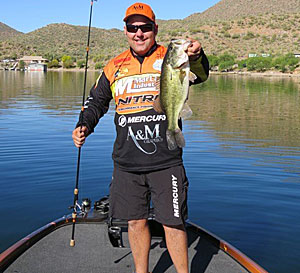
As for presentation, he fishes windy banks fast with a spinnerbait. In fact, on a windy day, he’ll fish horizontally almost exclusively – like crankbaits, spinnerbaits, and swimbaits. He keeps it high and fast. A lot of guys drift with the wind. Finley recommends you shouldn’t reel against the wind – he casts INTO the wind. So at times, he says, you may be fishing behind the boat, and both guys in the boat need to be agreed on this. Since you can make shorter casts with the choppy water cover, you can stay closer to shore and retrieve the bait with the wind.
My buddy Matt Shura agrees with the idea of the wind chop making it harder for the fish to see. He says it makes them less selective and more likely to commit to a reaction bait. He likes spinnerbaits, cranks, and jerkbaits on windy days, but if he’s been throwing something that’s been working, he’ll stick to it even if a wind comes up. At the ABA Championship, he and his partner were drop-shotting, and they kept it up after the wind picked up – he simply used the wind to move the boat.
Knowing how to control the boat and being proficient at using the trolling motor is key to fishing in the wind, says Shura. He faces the boat into the wind and then fishes behind – again, making sure your partner is okay with this. On the day they were drop-shotting, he had to keep the boat in 30 feet, cast to 10, and work to 25. So basically, he had the trolling motor on high all day facing the wind, only letting the boat move fast enough so that he could still feel a drop-shot rig.
Turn on the bilge pumps if the wind is so bad that the rollers are coming over the bow. You’ll be exhausted at the end of the day, and so will your batteries, but it will pay off. Matt has a 36-volt trolling motor and good batteries – good enough to keep them on high all day long, keeping the boat moving slowly even in 30 mph winds. The skill to control a bass boat in a high wind is something that only comes with practice, so be persistent.
The wind is fantastic for fishing but very tough on fishermen. You’ll have to be on one leg all day long in a big wind, using that trolling motor to keep the boat where you want it. Your back will ache, your legs will be exhausted, and you may even be soaked to the bone from rollers, but if you have what it takes to be a bass fisherman, you’ll learn to deal with the wind and even learn to love it. Next time it starts gusting while you’re on the water, tie on a reaction bait and practice casting into the wind. It may pay off for you big time.
Boat Safety in the Wind
One night, we were caught in a massive storm on Lake Pleasant, and it was no fun. The rollers were huge, and it was pitch black outside. Getting out of the boat onto the dock was very difficult – I crawled off the deck onto the pier. Many boats capsized that night. High wind is no joke, and if you don’t know how to drive in a high wind, get off the water or beach the boat in a protected cove. No fish is worth drowning for.
Always wear your life jacket on very windy days, even while fishing. A big roller can throw you overboard. If the wind is severe, head to shore or the dock and try to keep the boat at a 45-degree angle to the wind. If there is lightning, get under cover as soon as possible. I remember hiding under a railroad trestle at the Red Man All American one year. You do whatever it takes to keep yourself and your passengers safe. Visit the Coast Guard website at https://www.uscg.mil/ for more tips on safe boating.
When you need to trailer a boat in the wind, back the trailer at an angle toward the wind as much as possible and back it in a bit shallower than usual, use the wind and waves to help you get the boat on the trailer.


